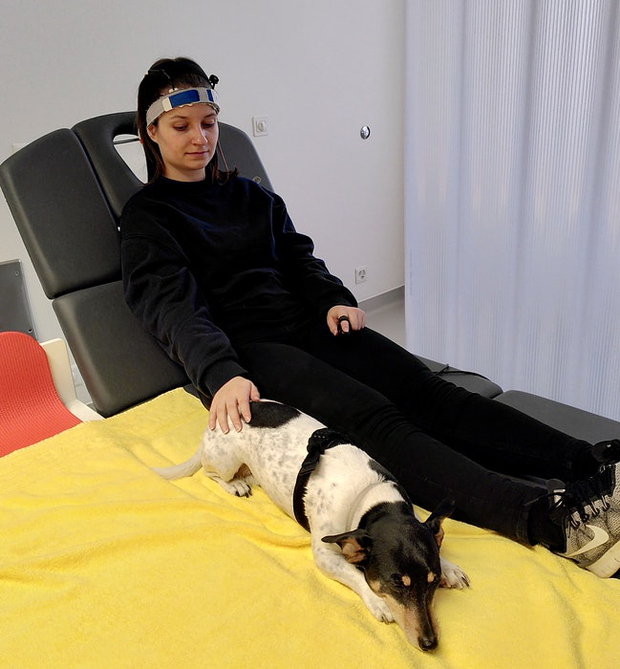The Surprising Brain-Boosting Benefits of Petting Dogs: New Study Unveils Findings
We all know that dogs bring profound emotional benefits to our well-being. But a recent study has revealed that these furry companions also have surprising ways of benefiting our brains.
The Surprising Brain-Boosting Benefits of Petting Dogs: New Study Unveils Findings
We all know that dogs bring profound emotional benefits to our well-being. But a recent study has revealed that these furry companions also have surprising ways of benefiting our brains.
Scientists have analyzed the impact of petting dogs on the prefrontal cortex of the brain, and the results show that this simple action can improve animal-assisted therapies for humans. The findings have been published in the journal PLOS ONE.
The prefrontal cortex plays a crucial role in processing emotions and regulating executive functions, such as attention, working memory, and problem-solving. Researchers wanted to explore how this part of the brain responds to interactions with dogs, one of the most common animals used in animal-assisted therapies.
Rahel Marti, the lead author of the study and a researcher at the University of Basel's Psychology Department, explained to Inverse: "We decided to start this study because very little is known about the brain's response to interactions with animals."

Dogs have lived alongside humans for thousands of years. During that time, we have domesticated and transformed them from fearsome wolves into obedient and loving pets. Dogs are also one of the most diverse species in the animal kingdom, thanks to our selective breeding. But beyond that, a recent study has scanned the brains of dogs and found profound changes when they live alongside humans.
Marti's research group analyzed the prefrontal cortex activity of 21 volunteers while they interacted with either a dog or a stuffed animal compared to neutral activities like staring at a blank wall. The researchers measured their brain activity using a non-invasive method called near-infrared spectroscopy, which measures the concentration of oxygenated blood in the brain. It is also advantageous over other brain imaging methods like fMRI, as participants can sit in a regular room and feel more comfortable.
For the activities related to the stuffed animal, the researchers placed it on the participants' lap for them to view and then they could pet the toy. Similarly, the dog would lie down, touch the participant, and then they were allowed to pet the animal.
The study yielded two significant findings that provide deep insights into the impact of dogs on the human brain.

Firstly, the brain activity in the prefrontal cortex increased when the participants had closer interactions with the stuffed animal or the live dog.
Marti said, "Our results confirm previous studies linking closer contact with animals or controlling stimuli to increased brain activation."
But the second finding was even more intriguing: participants experienced higher brain activity when petting the live dog compared to interacting with the stuffed animal. This aligns with previous research on horses and cats, but this study is the first to record increased brain activity in humans when interacting with dogs.

"We looked at different interactions: looking, feeling, and petting," Marti added.
While the brain activity decreased between the first and second interaction with the stuffed animal, the opposite happened when the volunteers interacted with the dog—a result that surprised the scientists. Though they still can't pinpoint exactly why the brain activity increases over time when petting the dog.
Marti explained, "Our interpretation is that participants established a bond with the dog."
That bond could bring a sense of emotional investment in the animal, leading to greater attention, represented by increased activity in the prefrontal cortex, when petting the dog compared to the stuffed animal. Previous research has shown that animals can enhance human attention, likely by strengthening the emotional connection with them—for instance, people are more likely to think about a dog's feelings when petting them.
Marti elaborated, "We think that emotional involvement may be a fundamental mechanism of brain activation in human-animal interactions."
The study suggests that petting a dog might elicit emotions and attention from us in a way that stuffed animals cannot. This could potentially benefit patients with diminished motivation, attention, and social communication function.
Marti said, "Our results could fit with therapeutic approaches to patients with deficits in motivation, attention, and social communication."
Further research will be needed to validate and build upon Marti's findings before dog-assisted therapies can be shown to help individuals with attention deficits. Future studies may focus on whether all participants benefit from enhanced emotional interaction and attention when petting live dogs or if these findings apply only to individuals who already enjoy dogs.



